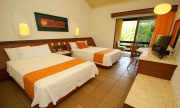This small but symbolic colonial town is set in the annals of national history as the birthplace of Mexico’s Independence movement. And it is precisely here, the priest Don Miguel Hidalgo y Costilla launched the September 16, 1810 legendary "cry of independence," rebelling against the domination of the Spanish crown. But what is the historical origin of Dolores Hidalgo?
Let’s go back to the times of the Aztecs, who were regarded as barbaric and inferior to many ethnic groups in Mesoamerica, giving them the generic name of "Otomi." It is believed that this word is derived from the Nahuatl word "totomitl" which means "bird arrow" or "arrows that lead hunters," but whatever its origin and meaning, the truth is that it was an indigenous culture that had been present for a millennia where today stands the town of Dolores Hidalgo, in the State of Guanajuato.
On that same ground those hunters founded a village called Cocomacan or "Place where they hunt turtle doves." They were colonized, but later they themselves would be a fundamental part of the colonizing of the Bajio region when the Viceroy of New Spain, Luis de Velasco y Castile y Mendoza (a position he held for two terms 1590-1595 and 1607-1611 as well as Viceroy of Peru in the period 1596-1604), decreed that Otomi families would accompany the Spanish to settle in territories occupied by warlike tribes, serving as a bridge for the sedentarization and subsequent Christianization of the nomads. Started in the colonial era, the first Viceroy of New Spain, Antonio de Mendoza, gave 2700 hectares of land grants as favor to the Spanish soldier García de Morón, which included precisely the village of Cocomacan.
However, the origin of this important destination of great national value is closely linked to the Hacienda de la Erre, founded in 1534 by Pedro Rodriguez de Montero, which was dedicated to raising cattle. It turns out that around 1610 this town took the name of San Cristobal and with the range of ranch being just below the territoriality of this famous property that, in turn, belonged to the current municipality of San Miguel de Allende. In 1643 the ranch rose to the rank of congregation. The priest Don Alvaro de Ocampo Osio made possible the extension of the congregation in 1643 through the purchase of land at the Hacienda de la Erre, who donated it to the neighbors, thus forming the original outline of town. Times of great prosperity and livestock farming came and with the consequent boom of Dolores, it allowed the start of construction of the Parish of Our Lady of Sorrows in 1712.
It was finished in 1778 at a total cost of $ 200,000.00 gold pesos. By 1790 it received the category of town being baptized with the name of Pueblo Nuevo de los Dolores, naming political figures of the town and its distinct unit that existed with the Village of San Miguel el Grande (now San Miguel de Allende).
Don Miguel Hidalgo y Costilla, the "founding father" came to the congregation of Dolores in 1803, where his social activity was essential. He developed various activities to benefit the population, such as pottery, carpentry, and a loom, in addition to planting mulberry trees and vines, hives, and training farmers and artisans. Father Hidalgo, a cultured and charismatic man, he wove a deep relationship with indigenous people and the mestizo of Dolores, which largely explains the influence he had on many of them to take up arms in pursuit of a new nation, free from what they considered the unjust subjugation Spanish.
And today, two centuries after this historic event that shook Mexico’s destiny, Dolores shines with a renewed brilliance, being the proud home of an unparalleled celebration of Mexican life: 200 years into our freedom as a nation, in which we have written our story with effort, passion and commitment. As relevant data on the chronology of Dolores, we find that on June 6, 1863, passing by the place, President Benito Juárez visited the home of Don Miguel Hidalgo, declaring it a property of the nation. A year later, precisely on September 15 and 16, an illustrious character of Dolores comes to visit the same property that held the Cry of Independence: Maximilian, Archduke of the House of Habsburg, who, called on by conservative groups in Mexico , assumed the crown of the Second Mexican Empire in 1863, albeit with disastrous results for him and his supporters, most notably Miguel Miramon, generally known as "the young Macabeo," hero of the Battle of Chapultepec Castle and the youngest president that Mexico has had in its history. On December 15, 1947, the XL Guanajuato State Legislature, by a new decree established that in the future the city will be called Dolores Hidalgo, Cradle of National Independence, which was also confirmed by a decree of President Miguel German Valdes (1946-1952) on December 31, 1948. It was President Lázaro Cárdenas (1934-1940) who initiated the September 15, 1940 tradition of shouting in the courtyard of his parish, but in 2010 this honor belonged to President Felipe Calderón (2006-2012). In addition to this, the city organized the fair of Dolores Hidalgo in the context of the Bicentennial of Independence, from September 4 to 19, 2010. This great event coincided with great examples of music and culture. A fundamental part of this festival was a tribute to the famous singer-songwriter Jose Alfredo Jimenez, a character famous for dolorenses pride and an icon of Mexican music, with the presence Mariachi Vargas de Tecalitlan and the Symphony Orchestra of Guanajuato. And precisely on this occasion of the national celebrations in Dolores the Museum of Independence had just opened, the same building which houses an important collection of objects alluding to the Independence of Mexico. The City of Dolores Hidalgo, the cradle of Mexico’s Independence, receives the tourism world with pride, party, music and joy like no other.









